
For about 100 years, the M1911 pistol was nearly synonymous with the .45 ACP that it was designed to fire. Sure, the .38 Super was trendy in the 1930s and again in the 1980s, but, for most shooters, mention of the M1911 pistol implied .45 ACP. I remember Ken Hackathorn showing off a custom M1911 in 9 mm Luger to a group of shooters about 18 years ago and hearing him say how sweet it was to shoot, but at that time it was basically a custom-only proposition. I found a Springfield Armory 9 mm conversion some time after and tried it on my trusty M1911 with mixed results. Neither accuracy nor reliability met my expectations, but Ken was right; the shooting characteristics were promising.
A few years later, custom 9 mm M1911s were popping up with greater frequency, and a few years after that mainstream makers began releasing models. There were a few primary options from big names for a bit, and then the market opened up with a broadness that suggests a genuinely hot trend. As an example, Colt alone has 17 different options in 9 mm Luger M1911s as of this writing. These range from traditionally styled carry models to competition-specific versions to full-featured specials such as the Combat Elite pictured here. It took a century, but a great pairing can’t be kept apart indefinitely.
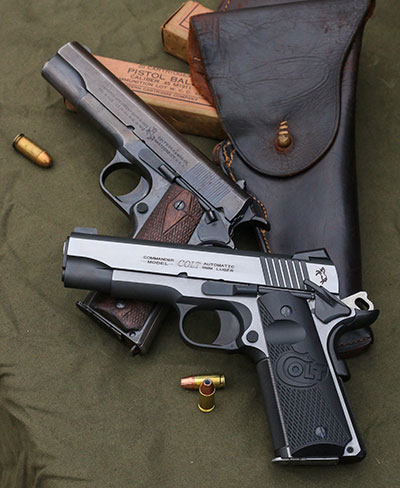
Generational Pull
I strongly suspect the current trend is fueled in large part by shifting perspectives on the 9 mm Luger cartridge itself from shooters across each generation. There is a sort of generational alignment with each group interested in 9 mm M1911s, although each has its own different reasons.
The silent generation and baby boomers largely drove the M1911’s refinement from either a tired service pistol or specialized bullseye target tool into the refined and customized combat pistol that we envision as today’s M1911. The pistol dominated early IPSC/USPSA competition, and with beavertails, better sights, extended controls and lengthened triggers, filled the holsters of elite military units and the FBI’s Hostage Rescue Team. These shooters, however, primarily viewed the M1911 as a tool specifically for launching the .45 ACP. Even when they did hesitantly embrace the 9 mm Luger cartridge, it was partly to take advantage of the capacity offered in double-stack platforms, such as the Beretta 92 and Glock 17.
With the passage of time, many of these shooters are now at an age where the recoil of even moderate .45 loads can be unpleasant on wrists and finger joints that have been hard at work for 60 to 80-plus years. These shooters have embraced the recent availability of the 9 mm M1911 as a way to keep shooting the platform they know so well and love. The 9 mm Luger chambering allows them to actually enjoy shooting or allows them to shoot a few more magazines of ammunition during a range session.
Another factor for the more seasoned shooters is that no cartridge has received the engineering and research and development attention that the 9 mm has, and modern loads are a far cry from the loads available during the boomers’ early shooting years. Lurid “9 vs. .45!!!” headlines sold a lot of gun magazines for many years, but don’t generate nearly the interest today now that we have decades of successful 9 mm use by law enforcement.
On the other end of the spectrum are the millennials. These shooters grew up in a 9 mm world where the pistols they saw on police gunbelts were Glocks, and the U.S. military was issuing Berettas. Every hero on both big and small screens was using a 9 mm. They often look at the .45 ACP much as my generation may view .45 Colt or .44 Spl.—a pleasant historical curio associated with another era. When the millennials began to dabble in M1911s they naturally wanted pistols in 9 mm Luger, and the market was just beginning to deliver.
It is the convergence of the older and younger generations having an interest in 9 mm M1911s that is fueling the wide availability. Of course, in between there are plenty of Gen X’ers like myself who simply enjoy the high-performance aspect of the legendary M1911 characteristics in a low-ammunition-cost, low-recoil, highly shootable package.
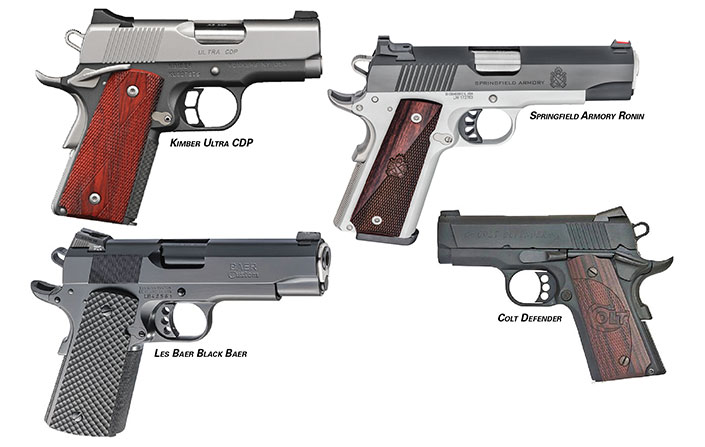
Performance
The 9 mm Luger-chambered M1911 is about as soft-shooting as a platform can be, particularly if the shooter tunes the recoil springs to standard-pressure loads. It is an absolute “ah-ha” moment of wonder that is fun to watch when someone accustomed to a typical 9 mm pistol fires their first few shots through the metric-sized M1911. They are genuinely surprised, and the comments among more experienced shooters typically include the terms “smooth-,” “soft-” and “flat-” shooting, often with immediate statements of intent to get one for themselves.
Aside from the softness, shooters who grew up on striker-fired pistols getting their first taste of a good M1911 trigger suddenly “get it” and are struck by how easy the platform is to shoot well. These shooters often shoot both faster and more accurately than they realized they could with the 9 mm M1911—and are near-instant fans. They may or may not set aside their current carry or defensive pistol, which is likely lighter, may have double the capacity and requires less maintenance, but they enjoy the M1911 in a way that probably surprises them. My father enjoys most semi-automatic pistol designs and shoots them well on his occasional trips out to the range. He shot exceptionally well with a 9 mm M1911, noticeable to the point that he surprised even himself.
In my own hands, I have come to realize that in many shooting scenarios for both speed and accuracy I will approach or set my best possible performance with a 9 mm M1911. During the past four years, I’ve tested six different 9 mm M1911s. Some have been featured here, such as the Rock River Poly and the Springfield Ronin. During this same time there have also been plenty of high-quality double-action/single-action and striker-fired guns that have passed through my hands. I enjoy each type and can use each with equal confidence. However, my personal data shows the 9 mm M1911s holding the top slot in accuracy as well as speed at the moment. A few of the top slots in some drills belong to customized double-action/single-action Berettas, but I am at the point where I often establish a benchmark for “good” with the single-action 9 mm and then see how other models compare.
It may not be the same way for everyone, but oftentimes I can actually outrun a semi-automatic .22 rimfire pistol with a 9 mm M1911, the faster perceived return to battery of the 9 mm compensating for the increase in muzzle rise. Even when the metric M1911 does not outshoot other platforms, it can often feel like it is—high speed or high accuracy just seems to come with a little less effort or more consistently with the single-action .35 cal. Plate racks at 10 yds. are a good example. I can run the plates about 15 to 20 percent faster with the 9 mm M1911 than I can with a tuned, striker-fired pistol, measuring bests with each platform. More importantly perhaps, my “safe” speed with the 9 mm Luger M1911 tends to be nearly the same as my “flat out” speed with favored Glock 17s.
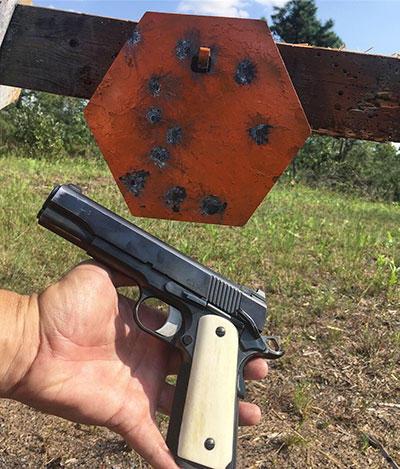
The earliest attempts to adapt the 9 mm Luger cartridge to the M1911 platform were somewhat mixed. The M1911 was designed around the .45 ACP, and the differences between the cartridges required some problem solving. I think the industry has largely moved beyond those initial hurdles, and current pistols seem to be reliable for the most part. One caveat goes for the M1911 as a whole, especially for the generation that “grew up Glock.” It is important to keep in mind that the M1911 thrives on regular lubrication at the locking points and along the contact surfaces. Some M1911s can require a reasonable level of cleanliness to prevent some balkiness, and brushing/wiping off the gunk at 300- to 500-round intervals might be prudent, whereas a Glock would be largely unaffected.
Perhaps the largest issue as a whole with the M1911, whether 9 mm or .45, is its internal extractor, which is essentially a tensioned hook. Although it can be perfectly reliable across many decades—I’ve fired multiple 100-plus-year-old M1911s that are still chugging along fine—some factories seem to set them haphazardly. The resulting unreliable extraction is fixed easily enough by the shooter with the aid of Internet videos and judicious flexing. The final caveat is that some shooters report their 9 mm M1911s as being magazine-sensitive. I haven’t experienced this in the current crop of pistols, but I have seen it in many .45s, so I wouldn’t be overly surprised to find a particular pistol that has preferences. Such considerations are just part of the M1911 landscape that includes its much-admired qualities.
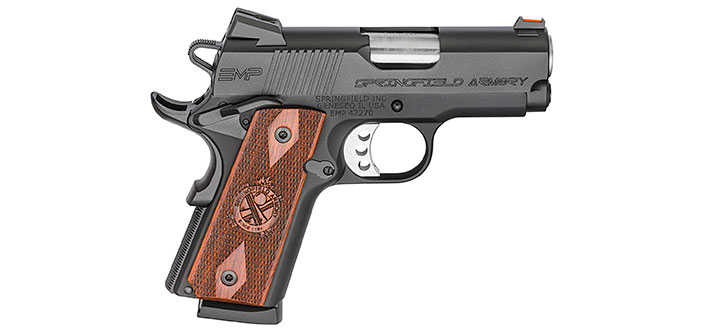
For the past two years, I’ve used a Dan Wesson Valor 9 mm with the high-polish blued finish that, sadly, has been discontinued, as one of my primary training and teaching pistols. I stopped rigorously tracking the round count after about 3,000, but the pistol has chugged along as smoothly and reliably as I could ask for. I give it a casual cleaning at about 1,000-round intervals and put three drops of Wilson Combat Lite oil on after most range trips, and the Valor runs without complaint. I’ve used both Wilson Combat and Metalform 10-round magazines with success other than a couple of the Metalforms that do not always drop completely free.
The M1911 is well-known for a great trigger and ergonomics, and the platform itself is often associated with accuracy. Of the 9 mm examples I’ve handled, accuracy has ranged from the better side of average to exceptional, with the median being pretty impressive. My Valor is a great example, with Sellier & Bellot’s new 150-gr. flat points averaging just barely over 1" at 25 yds. The cumulative average of 18 different loads (three listed below plus others from Federal, Speer, Hornady and handloads) was an impressive 1.45".
With that kind of precision underneath an M1911 trigger, and launching with relatively low recoil, real magic is possible. Shortly after I first picked up the Valor, I discovered that the regulation of the fixed sights allowed a repeatable hold on my 8" steel plates out to 70 yds. I soon realized that if I did everything right the Valor would reliably ring that steel. It was a confidence booster that led to attempts on the 70-yd. plate becoming a regular thing during my range trips.
Last spring, I was also working with a vintage National Match M1911, and over a period of weeks progressed through five straight hits, then eight, and even 10 out of 11, but 10 straight hits remained agonizingly just beyond reach. Later in the fall, I had the Valor out and was confirming hold at the 70-yd. plate with Speer 147-gr. Lawman and had that twinkly feeling that the light was perfect (seeing the small plate clearly behind the front sight is a large chunk of the challenge) and each shot was breaking unusually cleanly. I refilled the 10-round magazine and paced back to my 70-yd. spot. Flattening the first eight bullets onto the plate came unusually easy. Prior to the ninth I had to take a few moments to steel my nerves and the ‘Ding!’ had the sound of a hit toward the edge of the plate. I had a great feeling of confidence prior to the 10th shot that the months-long goal was just on the other side of one last press of that crisp M1911 trigger. The steel confirmed my hold, the ringing mixing with the barely suppressed cheers inside of my head. I raised the Valor and added an 11th hit just to fully slay the dragon.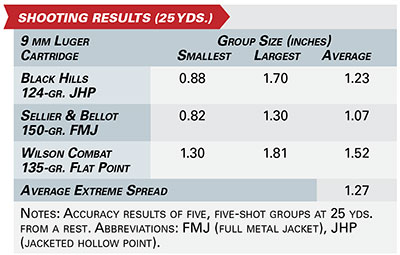 I look at the 9 mm Luger-chambered M1911 primarily as a skill-building tool, but it is also one of the most enjoyable 9 mm platforms for a casual range day. In fact, when someone is asking my opinion in the “what pistol should I … ” query—and the foremost purpose is simply enjoying range time and not CCW, home defense, etc.—I will often throw the 9 mm M1911 out there as a leading option. The 9 mm version of “Old Slabsides” also tends to give a pride of ownership that appeals to this type of shooter much more than the mainstream polymer/striker-fired pistols. Of course, that is not to suggest that a 9 mm M1911 is not a serious tool; I have several friends who carry pistols similar to the Colt Combat Elite every day. They don’t mind the extra ounces or the single-stack magazine capacity. While I have other primary carry pistols, I have certainly carried the Valor without concern on many occasions.
I look at the 9 mm Luger-chambered M1911 primarily as a skill-building tool, but it is also one of the most enjoyable 9 mm platforms for a casual range day. In fact, when someone is asking my opinion in the “what pistol should I … ” query—and the foremost purpose is simply enjoying range time and not CCW, home defense, etc.—I will often throw the 9 mm M1911 out there as a leading option. The 9 mm version of “Old Slabsides” also tends to give a pride of ownership that appeals to this type of shooter much more than the mainstream polymer/striker-fired pistols. Of course, that is not to suggest that a 9 mm M1911 is not a serious tool; I have several friends who carry pistols similar to the Colt Combat Elite every day. They don’t mind the extra ounces or the single-stack magazine capacity. While I have other primary carry pistols, I have certainly carried the Valor without concern on many occasions.
I wouldn’t be surprised if the 9 mm accounts for a larger percentage of M1911 sales with each of the next few years. I also think that the popularity of the platform and chambering is driving other innovations that attempt to capture M1911 feel and trigger qualities paired with a double-stack magazine. Pistols such as the Wilson Combat EDC X9, Staccato P and Dan Wesson DWX probably owe their market interest in part to the current 9 mm M1911 trend.
It is a small wonder that the cartridge that was associated with and has “Luger” in its name has become so popular in the iconic American pistol, but shooting one confirms that the 9 mm and the M1911 are a perfect pair.






































